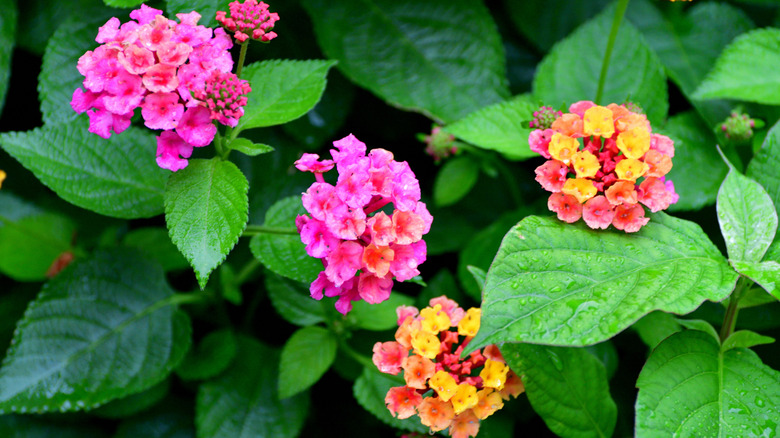The Fast-Growing Flower You Can Plant In July To Enjoy Gorgeous Blooms Into Fall
We may receive a commission on purchases made from links.
As the dog days of summer move in, you might be wondering if you still have time to add something new to your garden. July's scorching sun and rising soil temperatures can draw moisture away from newly planted flowers, causing them to wilt and even die before they have a chance to thrive. Even for drought-tolerant plants, the best time to plant is usually in spring or fall. But if you're hoping to add a pop of color to your garden during a heatwave, look no further than common lantana (Lantana camara). This heat-loving, drought-tolerant flower won't fade immediately when planted on a hot day, and its vibrant blooms often last into fall.
A frost-tender member of the Verbenaceae family, lantana sports a dense mat of deep green leaves topped with small clusters of warm-toned flowers. Combinations of red, yellow, orange, and pink, sometimes within the same cluster, make this pollinator magnet stand out. Citrus lantana is an especially beautiful cultivar to grow in fall due to its brilliant orange and red blooms.
Although this Central and South America native is an aggressive grower in any tropical climate, it's still a popular landscaping plant for much of the country, and there are many ways to enjoy lantana in your yard without it taking over. Many nurseries now offer sterile cultivars to control lantana's vigorous self-seeding habit. Planting your lantana in a container may also keep it from spreading, and it'll add a bright pop of color to any arrangement.
Lantana soaks up the late summer heat
Although it can be grown as a perennial in some areas, lantana is commonly planted as an ornamental annual to attract nectar-loving bees, butterflies, and hummingbirds. Once planted, this upright shrub establishes quickly and can reach 3 to 4 feet in height while continuously producing fragrant blooms. Deadheading, or removing spent flowers, may help promote new bud development, and most varieties will continue to bloom until temperatures drop in the fall.
While some varieties of lantana are hardy to USDA Hardiness zone 8, most are only hardy in zones 10 and 11. Although they flourish in humid areas, these plants don't tolerate wet or soggy soil and would prefer a dry, loose, and well-draining medium instead. Lantana's blooms are most prolific when the plant is placed in full sun — its ability to tolerate and even thrive in more than 8 hours of direct sunlight makes it a perfect candidate for planting in the heat of July and can withstand the late summer heat.
Despite its popularity with landscapers and pollinators, lantana can be tricky to handle in the garden. According to the Center for Invasive Species and Ecosystem Health, lantana is considered invasive in Florida, Alabama, and Georgia. In addition to its invasive status in several states, the plant has a strong smell and is considered toxic to most animals. The small hairs that cover lantana's leaves are also known to cause skin irritation, so it's a good idea to cover up with long sleeves and gloves. Once you've learned how to successfully grow and take care of your lantana, you can sit back and enjoy its dazzling blooms well into the fall.

